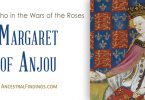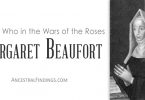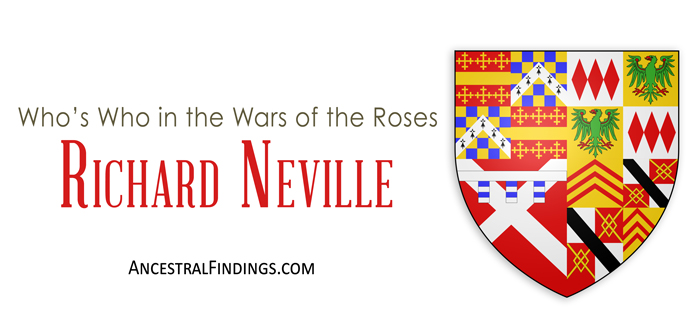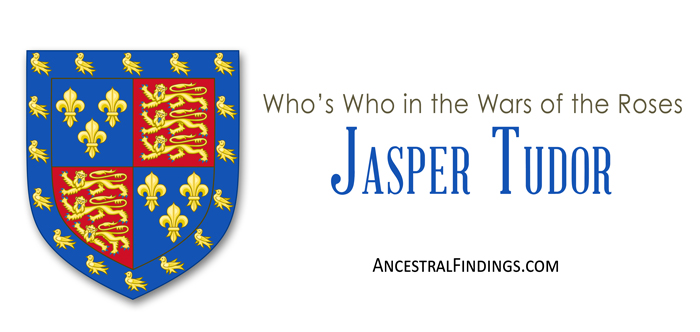Jacquetta of Luxembourg played an important part in the beginning of the Wars of the Roses. Though she didn’t live to see the war end, she knew she had founded a royal line that may go on for centuries… and, it did. Her direct descendants, through her eldest daughter, still sit on the throne of the United Kingdom today. Direct descendants from her other children and grandchildren range from members of the British nobility to commoners all over the world.
Born in approximately 1415 in Luxembourg, Jacquetta was the daughter of Peter of Luxembourg, Count of Saint-Pol and Margaret of Baux. Though born on the European continent and not an English native, Jacquetta had English ancestry. Her paternal great-grandmother was a direct descendant of King Henry III of England, and her maternal grandmother was a direct descendant of King John of England (the same King John of Robin Hood fame).
She was born during the 100 Years War between England and France, and her uncle, John II of Luxembourg, was the leader of the army that captured Joan of Arc. John held Joan at his castle for some time before selling her to the English, who executed her, and some historians speculate the young Jacquetta may have met Joan during her time at her uncle’s castle.
Jacquetta was later married, at age seventeen, to John of Lancaster, 1st Duke of Bedford, the brother of King Henry V of England. This prominent position made her the most important lady in England for a time, as Henry V was dead and his young son, the new King Henry VI, was not yet married. When he did marry shortly after Jacquetta joined the family, she became the second lady in England, behind only the new queen.
Her marriage to John of Lancaster was a short one, as he was much older than her, and died after two years of marriage. They had no children together. However, being barely twenty years old, Jacquetta was not going to remain unmarried for long. In fact, she’d developed a close friendship with her husband’s chamberlain before his death. That chamberlain, of common birth and well below her station, was Sir Richard Woodville.
Jacquetta and her first husband were in the English-occupied French territory of Calais when the duke died, and Richard Woodville was sent by King Henry VI to bring her back to England. Their friendship turned into love, and they married in secret, which was against the king’s orders that she not marry again without royal permission. Henry refused to see Jacquetta or Richard for a while, but their payment of a fine equal to about $1,000 modern dollars mollified him, and he allowed them to return to court.
Jacquetta was entitled to keep her title of Duchess from her first marriage, and was always known as the Duchess of Bedford, even after her marriage to Sir Richard Woodville. Richard became prominent at Henry VI’s court as Jacquetta was related to both the king and queen by marriage. She was the king’s aunt by marriage through her first husband, and her sister had married the queen’s uncle. Through the influence of his queen, Margaret of Anjou, who was close friends with Jacquetta, Henry VI made Richard Woodville a baron, which was a much more suitable title for a man married to a duchess, and he became known as Sir Richard Woodville, Baron Rivers.
Jacquetta and Richard had fourteen children together. When the Wars of the Roses broke out, they fought solidly on the Lancaster side, which was the side of King Henry VI and Margaret of Anjou, their good friends, and relatives. However, it was their eldest child, Elizabeth Woodville, who changed everything for Jacquetta, Richard, and their entire family.
Elizabeth was married at a young age to Sir John Grey, a knight who fought on the Lancastrian side of the war. When he was killed in battle, his mother refused to give Elizabeth’s two sons with John their rightful inheritance of property from the Grey estate. By then, the Lancastrians had lost the throne to the York side of the war, at least for the time being, and the new Yorkist King Edward IV was on the throne. Elizabeth petitioned the new king in person to get her sons’ inheritance for them, and he agreed. He also fell madly in love with her, and they were married in secret, with only Jacquetta, a choir boy, and a priest as witnesses. Their marriage was kept secret for a few months until Edward’s cousin was about to announce he had secured a betrothal for Edward to a French princess. Then, Edward revealed the marriage.
Elizabeth was now the queen, and Jacquetta was the queen’s mother. Only, after years of fighting for the Lancasters, Jacquetta was the mother of a Yorkist queen. The entire Woodville family had to switch sides and become Yorkists. This meant Jacquetta giving up her long time close friendship with the deposed queen, Margaret of Anjou.
Edward’s marriage to Elizabeth Woodville enraged his cousin, who had helped him take the crown. This cousin, Richard Neville, began to fight against Edward in a goal to put Edward’s brother, George, on the throne in his place. During one of the many battles and skirmishes that took place during this time, Richard Neville’s forces captured Sir Richard Woodville, Baron Rivers, along with his son, John Woodville, and had both of them beheaded illegally and without trial. This earned him enemies in the queen and her mother. Jacquetta’s husband and son had just been killed (and they were also the queen’s father and brother).
Eventually, Richard Neville and his forces secured enough of a victory to force Edward IV from the throne and put Henry VI back on it. During that time, Elizabeth Woodville fled to sanctuary at Westminster Abbey with her children, and Jacquetta was put on trial for witchcraft. Richard Neville argued that Jacquetta, being one of the few witnesses to Edward’s marriage to Elizabeth, used witchcraft to make the king fall in love with her daughter. He used some partially melted pewter figurines of Edward and Elizabeth found on Jacquetta’s property as evidence. Because of her former friendship with the restored queen and her familial relationship with Henry VI, however, no one on the jury felt comfortable convicting her, as they were concerned about reprisals from the restored monarchs. Jacquetta was set free and joined Elizabeth in sanctuary, where she helped her deliver her sixth child and first son by Edward, also named Edward, after his father.
After six months back on the throne, Henry VI was deposed again, this time for good. Edward IV was back on the throne, Elizabeth Woodville was queen once more, and Jacquetta’s good name was restored after Edward formally dismissed the witchcraft charges against her. Henry VI went back to the Tower of London, where he was killed soon after (most historians believe Edward IV and his brothers did it, or at least ordered it), his son and only heir was killed in battle, and Margaret of Anjou was captured and put in the Tower for a few years until her French relatives ransomed her and she returned to France, where she remained for the rest of her life.
Jaquetta spent the rest of her life being a devoted mother and grandmother, and died in 1472, three years after her beloved husband was killed. The witchcraft allegations against her were briefly revived by Edward’s younger brother, who later became King Richard III. As Richard III, he used the assertion that Jacquetta had used witchcraft to make Edward fall in love with Elizabeth as part of his case for declaring their marriage illegal, which made all of their children illegitimate and allowed him to become king. However, due to lack of evidence, the witchcraft charge against the deceased Jacquetta didn’t hold up and was not one of the arguments that ultimately won Richard the crown.
After Richard III was killed in battle by Henry Tudor’s army two years after becoming king, the new King Henry VII married the eldest daughter of Edward IV and Elizabeth Woodville, Elizabeth of York, Jacquetta’s granddaughter. Through Elizabeth of York, Jacquetta and her husband Richard, became the direct ancestors of every monarch to sit on the English throne afterward, even up to the present Queen Elizabeth II.






